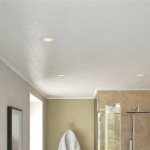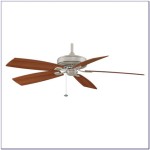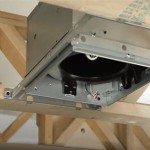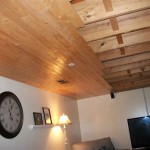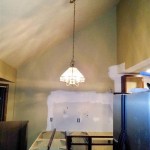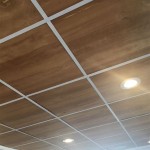What Are School Ceiling Tiles Made Out Of?
Ceiling tiles are a ubiquitous feature of educational environments, commonly found in classrooms, hallways, administrative offices, and other areas within school buildings. These tiles serve various purposes, including aesthetic appeal, sound absorption, fire resistance, and insulation. Understanding the composition of school ceiling tiles is essential for several reasons, ranging from maintenance and replacement considerations to environmental and health concerns. The materials used in their construction significantly influence their performance, durability, and overall impact on the school environment.
The selection of materials for ceiling tiles is a crucial decision, often dictated by factors such as budget constraints, building codes, desired acoustic properties, and the specific needs of the school facility. Historically, asbestos was a prevalent component in ceiling tiles, particularly in older buildings. However, due to well-documented health risks, its use has been widely discontinued and replaced with alternative materials. Modern ceiling tiles are typically manufactured from a variety of substances, each offering distinct advantages and disadvantages.
This article will delve into the primary materials used in the production of school ceiling tiles, examining their properties, applications, and potential implications for the school environment. We will explore common components like mineral fiber, fiberglass, gypsum, and metal, providing a detailed overview of their characteristics and the manufacturing processes involved. Furthermore, we will address factors influencing material selection and the growing emphasis on sustainable and eco-friendly alternatives.
Mineral Fiber Ceiling Tiles
Mineral fiber ceiling tiles represent a significant portion of the ceiling tile market, owing to their balance of performance and cost-effectiveness. These tiles are primarily composed of mineral wool, also known as rock wool or slag wool, which is a fibrous material produced from molten rock, slag, or glass. The manufacturing process involves melting these materials at high temperatures and then spinning or drawing them into fine fibers. These fibers are then bonded together using various binders to form a solid, cohesive structure. Common binders include starch, clay, and recycled paper.
The composition of mineral fiber tiles often includes recycled content, enhancing their sustainability profile. Recycled materials such as newsprint, cardboard, and other paper products are frequently incorporated into the fiber mix. This reduces the demand for virgin resources and diverts waste from landfills. The percentage of recycled content can vary depending on the manufacturer and the specific product line.
Beyond the core mineral fiber and binder components, specific additives may be included to enhance certain properties of the tiles. For example, fire retardants are often added to improve their fire resistance, while biocides may be incorporated to prevent the growth of mold and mildew. Surface treatments are also common, ranging from simple paint coatings to more sophisticated laminates that improve aesthetics and durability.
The acoustic properties of mineral fiber ceiling tiles are a key advantage in educational settings. The porous nature of the material allows it to absorb sound waves, reducing reverberation and echo within classrooms and hallways. This can significantly improve speech intelligibility and create a more conducive learning environment. The sound absorption performance of a particular tile is typically measured by its Noise Reduction Coefficient (NRC), with higher NRC values indicating better sound absorption.
In terms of installation, mineral fiber ceiling tiles are generally lightweight and easy to handle, simplifying the installation process. They are typically installed in a suspended grid system, allowing for easy access to utilities and services above the ceiling. Maintenance requirements are relatively low, with occasional cleaning to remove dust and dirt. However, mineral fiber tiles can be susceptible to damage from water leaks or high humidity, which can cause warping or sagging. Proper ventilation and moisture control are essential to ensure their longevity.
Fiberglass Ceiling Tiles
Fiberglass ceiling tiles represent another popular option for school applications. Similar to mineral fiber tiles, fiberglass tiles are valued for their acoustic performance and fire resistance. However, they differ significantly in their composition and manufacturing process. Fiberglass tiles are made from fine glass fibers bonded together with a resin binder. The glass fibers are typically produced by melting silica sand and other raw materials at high temperatures and then spinning them into fine strands.
The structure of fiberglass ceiling tiles is characterized by a high degree of porosity, which contributes to their excellent sound absorption capabilities. The open cell structure allows sound waves to penetrate the material and dissipate energy, reducing noise levels within the space. Like mineral fiber tiles, fiberglass tiles are often rated by their NRC value, reflecting their sound absorption performance.
One significant advantage of fiberglass ceiling tiles is their resistance to moisture and humidity. Unlike mineral fiber tiles, fiberglass tiles are less prone to warping or sagging in damp environments. This makes them a suitable choice for areas with high humidity levels or where water leaks are a potential concern. The inherent resistance to moisture also inhibits the growth of mold and mildew, contributing to improved indoor air quality.
Fire resistance is another key attribute of fiberglass ceiling tiles. The glass fibers are inherently non-combustible, providing a high level of fire protection. Many fiberglass ceiling tiles meet stringent fire safety standards and are classified as Class A fire-rated materials. This ensures that they will not contribute to the spread of flames in the event of a fire.
The manufacturing process of fiberglass ceiling tiles can involve the use of recycled glass, further enhancing their sustainability profile. Utilizing recycled glass reduces the demand for virgin materials and contributes to waste reduction efforts. The resin binders used in fiberglass tiles can also be formulated to minimize volatile organic compound (VOC) emissions, promoting healthier indoor air quality.
Installation and maintenance of fiberglass ceiling tiles are generally straightforward. They are typically installed in a suspended grid system, similar to mineral fiber tiles. Maintenance requirements are minimal, with occasional cleaning to remove dust and dirt. However, it is important to handle fiberglass tiles with care during installation and maintenance to avoid skin irritation from the glass fibers. Protective gloves and clothing are recommended when working with these materials.
Gypsum Ceiling Tiles
Gypsum ceiling tiles offer a distinct alternative to mineral fiber and fiberglass tiles, providing a different set of properties and aesthetic options. Gypsum is a naturally occurring mineral composed of calcium sulfate dihydrate. It is widely used in construction materials, including drywall, plaster, and ceiling tiles. Gypsum ceiling tiles are typically manufactured by combining gypsum with other additives and then forming it into panels of various sizes and shapes.
One of the primary advantages of gypsum ceiling tiles is their smooth, monolithic appearance. Unlike the textured surfaces of mineral fiber and fiberglass tiles, gypsum tiles can be finished with a smooth, paintable surface, allowing for a seamless and visually appealing ceiling. This makes them a popular choice for areas where aesthetics are a priority.
Gypsum ceiling tiles also offer good fire resistance. Gypsum is a naturally fire-resistant material, and it contains water molecules that are released when exposed to heat, helping to slow the spread of flames. Gypsum ceiling tiles can meet stringent fire safety standards and provide a significant level of fire protection.
In terms of acoustic performance, gypsum ceiling tiles are generally less effective at sound absorption compared to mineral fiber and fiberglass tiles. However, they can still contribute to noise reduction by reflecting sound waves and reducing reverberation. To improve the acoustic performance of gypsum ceilings, perforated panels or sound-absorbing backings can be used.
The manufacturing process of gypsum ceiling tiles is relatively energy-efficient compared to the production of other ceiling tile materials. Gypsum is readily available and requires less energy to process than materials like mineral wool or fiberglass. Additionally, gypsum ceiling tiles can be recycled, further enhancing their sustainability profile. Recycled gypsum can be used to manufacture new gypsum products, reducing the demand for virgin resources.
Installation of gypsum ceiling tiles typically involves a more complex process compared to mineral fiber and fiberglass tiles. They are often installed using a specialized grid system or directly attached to the ceiling structure. Finishing work, such as taping and painting, is usually required to achieve a smooth, seamless appearance. Maintenance requirements are similar to other ceiling tile types, with occasional cleaning to remove dust and dirt. However, gypsum tiles can be susceptible to damage from water leaks, so proper moisture control is essential.
In addition to the core materials described above, other materials are sometimes used in the construction of school ceiling tiles, depending on the specific requirements of the project. Metal ceiling tiles, typically made from aluminum or steel, are often used in areas where durability and resistance to impact are important. These tiles can be perforated or combined with sound-absorbing materials to improve their acoustic performance. Wood ceiling tiles offer a natural and aesthetically pleasing option, but they are typically more expensive and may require additional fireproofing treatments. Furthermore, increasingly, bio-based and rapidly renewable materials are being explored for ceiling tile production, aiming to reduce the environmental impact of these ubiquitous building components.
School Ceiling Tiles Acoustical Ceilings For Schools Kanopi By Armstrong
School Ceiling Tiles Acoustical Ceilings For Schools Kanopi By Armstrong
School Ceiling Tiles Acoustical Ceilings For Schools Kanopi By Armstrong

Factory Acoustic 600x600 Ceiling Tiles For School Hospital Building 2024 Made In China Com
School Ceiling Tiles Panels At Rockfon Company

Factory Direct Supply 600 600mm Hospital Hotels School Building Material Fiberglass Ceiling Tiles Panel Made In China Com

Asbestos In Schools A Guide For Pas Faculty

Acoustic Decorative Mineral Fiber Wool Drop Ceiling Tiles For School Board Made In China Com

Ceilings For Education Armstrong Ceiling Solutions Commercial

School Zone Fine Fissured Armstrong Ceiling Solutions Commercial
Related Posts

